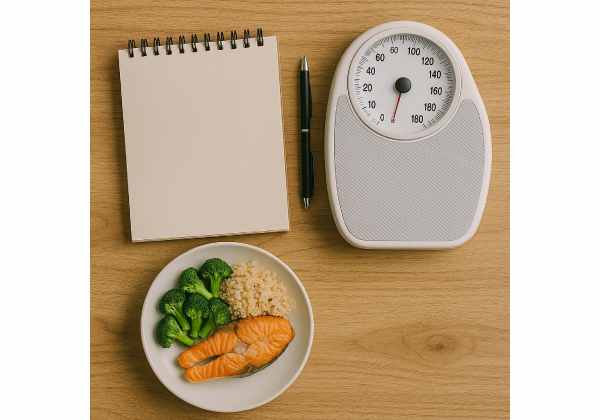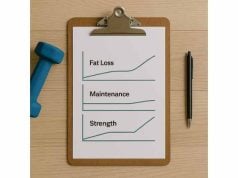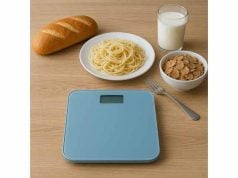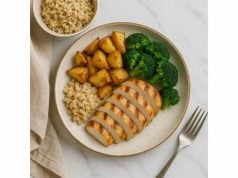
You reached your goal. Now the goal has to stick. The first eight weeks after a diet decide whether progress becomes your default or fades under busy days, social meals, and creeping portions. This playbook gives you a clear structure for maintenance—how to set calories you can live with, build guardrails that do not feel like a diet, and run fast weekly check-ins that catch drift early. You will see exactly when to tighten, when to pause, and how to manage weekends and travel without losing momentum. If you are not sure whether you are facing a true stall or normal noise, start with our concise plateau and maintenance troubleshooting guide before you change anything.
Table of Contents
- Week 1: Regain prevention setup
- Week 2: Find maintenance calories
- Weeks 3–4: Maintenance macros that satisfy
- Weeks 5–6: Keep daily movement up
- Weekends and travel guardrails
- Check-ins, data and action triggers
- If weight creeps up early
- FAQ
Week 1: Regain prevention setup
Maintenance is not a pause; it is a training block with new objectives: stabilize weight, restore energy, and make your “default day” align with the body you want to keep. In Week 1, you will design a light structure that prevents drift without returning to diet rigidity.
Define success for the next eight weeks
- Weight band: choose a ±0.5% range around your current average. If you weigh 72 kg, your band is ~71.6–72.4 kg.
- Waist steady: ±0.5–1.0 cm week to week.
- Performance: hold or improve 1–2 key lifts, or keep steady running pace at the same effort.
- NEAT: daily steps at or above your personal floor (set in Section 4).
Lock in your non-negotiables
Pick three to five guardrails that address your real friction points. Examples:
- Protein at every meal (25–40 g) to steady appetite.
- Veg twice per day for volume and fiber.
- 3×10-minute post-meal walks to lift NEAT with minimal time cost.
- Planned night snack (150–250 kcal, protein-forward) to prevent raids on the pantry.
- Restaurant rule of one: choose either a drink, dessert, or richer sides—not all three.
Set default meals for busy days
Defaults reduce decision fatigue. Choose:
- One workday breakfast and one workday lunch you can repeat.
- Two or three rotating dinners that fit your maintenance macros.
- Grab-and-go protein (skyr, Greek yogurt, eggs, edamame, jerky) always stocked.
Rebuild flexibility deliberately
Add back one flexible meal this week—a dinner out or a social lunch—while keeping your guardrails. Practice ordering protein-first, vegetables on the side, and deciding before you sit down whether you will enjoy a drink or dessert.
How to weigh and interpret the scale
- Weigh daily, in the morning, after the bathroom.
- Record a 7-day average.
- Expect a short-lived bump (0.5–1.5% of body weight) as carbs and sodium rise. Judge maintenance only by weekly averages, not a single morning.
Big-picture refresher if needed: if your fundamentals were shaky during the cut, skim our overview of healthy weight loss basics so you are not building maintenance on sand.
Mindset for Week 1
- Replace “perfect days” with good weeks.
- Keep structure light but visible.
- Your goal is stability, not constant improvement.
Week 2: Find maintenance calories
You do not need a perfect formula; you need a working estimate and a feedback loop. Week 2 sets your maintenance calories and tests them against real data.
Start with a practical estimate
- Add +300–500 kcal/day to your final cutting intake if you were losing ~0.5–0.7% per week.
- If you did not track, estimate maintenance from body weight, activity, and job demands—then verify with two weekly averages.
Confirm with the maintenance band
- If your 7-day average and waist are stable within the bands you set in Week 1, you are close enough.
- If weight climbs >1.0% across two weeks and waist rises, you overshot. Trim 100–150 kcal/day and retest.
- If weight dips >0.5% with rising hunger or training fatigue, add 100–150 kcal/day.
Allocate calories to fit your life
- Direct 20–50 g carbs toward training and dinner if evenings are your weak point.
- Keep a fat floor of 0.6–1.0 g/kg/day from olive oil, nuts, seeds, avocado, and dairy.
- Maintain protein at 1.6–2.2 g/kg/day split across 3–5 meals.
Use a range, not a point
Give yourself a maintenance band of ±150–200 kcal. Social meals and harder training days fit inside the band without mental math spirals.
Menu tweaks that increase satiety
- Push 25–40 g protein at breakfast (e.g., skyr and fruit, eggs and beans).
- Add 8–12 g fiber at dinner (vegetables, legumes, whole grains).
- Hold liquid calories for special occasions; they add up fast without helping hunger.
For a clear walkthrough with examples, use our step-by-step method to find maintenance calories and dial the number without guesswork.
What success looks like this week
- Weight average and waist stable after the initial water bump.
- Training feels better with the extra energy.
- Hunger manageable most days with your default meals in place.
Weeks 3–4: Maintenance macros that satisfy
Calories set the destination; macros and meal design determine how comfortable the trip feels. In Weeks 3–4 you will shape protein, carbs, fats, and fiber to curb evening appetite, fuel training, and keep the scale steady.
Protein: the anchor
- Target 1.6–2.2 g/kg/day, evenly spread.
- Practical split for many: 30–40 g at breakfast and lunch; 35–45 g at dinner; 15–25 g in a planned snack if needed.
- Easy adds: whey or skyr, cottage cheese, edamame, eggs, tofu, fish, chicken, lean beef.
Carbs: place where they work
- Pre-workout: 20–40 g to raise performance.
- Post-workout: 40–60 g to refill glycogen and reduce cravings later.
- Dinner: 30–60 g for satiety and sleep quality, especially if late-night snacking derailed you in the past.
Fats: floor for hormones and flavor
- Keep 0.6–1.0 g/kg/day.
- Use olive oil, mixed nuts, avocado, quality dairy to make meals satisfying without pushing calories up unintentionally.
Fiber: your quiet appetite tool
- Aim for 25–40 g/day with 8–12 g in the final meal to blunt evening hunger.
- Use a variety: vegetables, lentils, beans, oats, berries, whole-grain rice or pasta, potatoes with skin.
Design your evening routine
- A high-satiety dinner: protein + veg + starch + 10–15 g added fats.
- A pre-decided night snack if cravings persist: 150–250 kcal combining protein + fiber (e.g., skyr and berries; cottage cheese and tomato; protein pudding and kiwi).
- Pair with a 10-minute walk to reduce restlessness.
If you want macro targets by body size and training example menus, see our practical overview of maintenance macros to lock your plan without overthinking.
Two-week macro experiments
- Dinner protein up: add 10–15 g protein at dinner for 14 days; rate hunger and sleep.
- Carbs to training: move 30–50 g from lunch to the pre/post-workout window; track performance.
- Fiber at night: add 8–12 g fiber to dinner; note late snacking frequency.
Keep only the change that made evenings calmer and kept averages steady.
Weeks 5–6: Keep daily movement up
Diet fatigue fades, then life expands. NEAT (non-exercise activity thermogenesis) quietly slips if you do not protect it. Weeks 5–6 focus on repeatable movement anchors that raise energy expenditure without formal workouts.
Build movement into meals and tasks
- 3×10-minute post-meal walks: breakfast, lunch, dinner.
- Errand on foot: choose one daily (mail, groceries, coffee).
- Stand for 60–120 seconds every 40–60 minutes during desk blocks.
Set and defend your step floor
- Pick a realistic floor you can hit on busy days (many do well at 7–10k).
- Use a rebound plan: if a day ends 2k short, top up the next day with an extra 15–20 minutes of walking.
Keep training simple and sustainable
- 2–4 strength sessions per week, 45–60 minutes, leaving 1–3 reps in reserve.
- 2–3 easy cardio sessions or brisk walks.
- Focus on consistency, not heroic efforts.
Make low-effort swaps
- Meetings on the phone? Walk and talk.
- Park further, take stairs, carry groceries in two trips.
- Household chores count—vacuuming, yard work, laundry runs.
If movement tends to fall during cuts and rebounds messily after, read our tight guide on how to keep daily movement up with anchors that survive busy weeks.
Output matters, but so does feel
You should feel warmer, more alert, and less restless after walks. If you feel depleted, sleep and calories may be low; revisit Sections 2 and 3.
Weekends and travel guardrails
Most regain begins on weekends and trips—not from one big meal, but from structure disappearing for 48–72 hours. This section gives you guardrails that keep joy and reduce drift.
Anchor the day before it starts
- Anchor breakfast both weekend days: protein + fruit + grain.
- Hydrate and walk: 500 ml water and a 10-minute walk after waking.
- Two-hour movement window across the day (walks, chores, playground time).
Restaurant rule of one
At meals out, enjoy one of these freely:
- A drink
- A dessert
- Richer sides
Keep the others lighter. You will leave satisfied and still inside your maintenance band.
Buffets and events
- Protein first, then vegetables, then starch.
- Make your first plate your only plate—go back for coffee or fruit if the event runs long.
Travel rhythm
- Pack portable protein (skyr, jerky, whey, roasted edamame).
- Maintain sodium consistency where you can and judge weight by weekly averages once home.
- Bookend your biggest meal with 10-minute walks.
For more targeted strategies by season, destination, and schedule chaos, use our quick primer on holiday and travel maintenance to keep momentum without food rules that steal the event.
Mindset
- Decide before the meal what matters most.
- Enjoy what you choose fully.
- Return to your defaults at the next meal—no compensation games.
Check-ins, data and action triggers
A 10-minute weekly check-in prevents small slips from becoming regain. You will track four metrics, apply simple thresholds, and use pre-decided actions.
Track these once per week
- Weight trend: average of daily morning weigh-ins.
- Waist or navel: measured once, same spot and posture.
- Step average: across the week.
- Training quality: best set, pace, or perceived effort.
Add a food visibility check
- For three evenings, write what you planned to eat after dinner and what you actually ate. This catches quiet calorie creep early.
Thresholds that trigger action
- Weight: 7-day average up ≥0.75–1.0% from baseline for two weeks.
- Waist: up ≥1.5 cm for two readings.
- Steps: weekly average >1,500/day below your floor for two weeks.
- Training: losing a rep or load on two key lifts for two weeks despite sleep.
Actions (choose one, run 14 days)
- Reinstate default breakfast and lunch on workdays.
- Install or restore 3×10-minute post-meal walks.
- Macro timing: move 20–40 g carbs to pre/post-workout and dinner.
- Small calorie trim: reduce 100–150 kcal/day from oils, desserts, or snacks.
For a minimal daily routine so the scale does not mislead, use our straightforward daily weigh-in protocol to get honest trends from noisy numbers.
Review after two weeks
- Back within your bands? Keep the change.
- Not yet, and fatigue is high? Consider raising calories modestly for recovery.
- Not yet, fatigue low? Hold the change or add one additional lever.
If weight creeps up early
Regain rarely arrives as a surprise; it shows up as patterns. Catch them and fix them small.
Find the pattern
- Evenings: unplanned snacks push you 300–500 kcal over.
- Weekends: structure disappears; steps plummet.
- Water noise: salty meals or bigger carb days create 1–2 kg swings with no waist change.
- Movement slump: sitting blocks grow; step floor is no longer defended.
Pick the smallest effective fix
- Evenings: add 10–20 g protein and 8–12 g fiber to dinner; pre-plan a 150–250 kcal snack.
- Weekends: keep anchor breakfast, schedule a movement window, use the restaurant rule of one.
- Water noise: hold sodium steady for seven days and reassess averages.
- Movement slump: reinstall post-meal walks and one errand on foot daily.
Time-box, then decide
- Run the fix for 14 days.
- Compare two 7-day averages for weight, waist, steps, and training.
- If back inside your bands, continue.
- If not, choose either a 100–150 kcal trim or a 2–4 week mild deficit (250–300 kcal/day) with all guardrails intact, then re-enter maintenance deliberately by adding back 100–150 kcal and holding steady for two weekly averages.
Mindset for months, not weeks
- Your environment will keep changing—seasons, stress, travel.
- Maintenance skills are portable: defaults, guardrails, weekly check-ins, and small, fast actions.
- You are aiming for boring consistency that frees you to live more, not think about food more.
FAQ
How much should I raise calories after a cut?
Most people add 300–500 kcal/day to their final cutting intake, then judge by two weekly averages and a waist check. Expect a temporary water bump as carbs and sodium rise. If hunger is high or training is flat, add another 100–150 kcal/day and reassess.
Do I need to track forever at maintenance?
No. Track closely for the first 4–8 weeks while guardrails become automatic. Keep a weekly check-in with weight averages, waist, and steps. When trends are stable, shift to light tracking: default meals, planned night snack, and periodic weigh-ins.
Why did my weight jump even though I ate at maintenance?
It is often water and glycogen, not fat—especially after salty meals or higher-carb days. Keep sodium consistent, hydrate, and judge by 7-day averages and waist. If averages hold steady over two weeks, you are on track.
What if weekends keep derailing me?
Keep anchor breakfast, schedule a movement window, and use the restaurant rule of one (drink or dessert or richer sides). Pre-plan a protein-forward night snack. If drift continues, try a short maintenance plan for weekends only until habits stick.
How many steps should I aim for at maintenance?
Pick a realistic floor—often 7–10k—that you can hit on busy days. Protect it with post-meal walks and stand breaks. If your weekly average falls >1,500/day below your floor for two weeks, reinstall movement anchors before changing calories.
When should I raise or lower calories at maintenance?
Raise 100–150 kcal/day if steps and training slump for two weeks despite good sleep and structure. Lower 100–150 kcal/day if your 7-day average weight and waist rise beyond your bands for two weeks. Time-box any change for 14 days, then reassess.
Do I need different macros now than during the cut?
Protein stays high (1.6–2.2 g/kg/day). Keep a fat floor (0.6–1.0 g/kg/day) and place 20–50 g carbs around training and dinner for performance and satiety. Use a maintenance band (±150–200 kcal) for flexibility instead of chasing exact numbers daily.
References
- A systematic review, meta-analysis and meta-regression of the effect of protein supplementation on resistance training-induced gains in muscle mass and strength in healthy adults 2018 (Systematic Review & Meta-analysis)
- Systematic review and meta‐analysis of protein intake to support muscle mass and function in healthy adults 2022 (Systematic Review & Meta-analysis)
- After Dinner Rest a While, After Supper Walk a Mile? A Systematic Review with Meta-analysis on the Acute Postprandial Glycemic Response to Exercise Before and After Meal Ingestion in Healthy Subjects and Patients with Impaired Glucose Tolerance 2023 (Systematic Review & Meta-analysis)
- Daily steps and all-cause mortality: a meta-analysis of 15 international cohorts 2022 (Meta-analysis)
- Dietary fiber influence on overall health, with an emphasis on CVD, diabetes, obesity, colon cancer, and inflammation 2024 (Review)
Disclaimer
This playbook is general education about weight maintenance and regain prevention. It is not a substitute for personalized medical advice, diagnosis, or treatment. If you have medical conditions, take medications that affect appetite or glucose, or have a history of disordered eating, consult your clinician or a registered dietitian before changing your plan.
Share and follow
If this first-eight-weeks plan helped, consider sharing it with a friend starting maintenance. For practical templates and future updates, follow us on the social platform you use most—Facebook, X (formerly Twitter), or another network you prefer.










